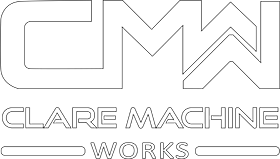Hydraulics technology is used to power anything from car brakes and garbage trucks to motorboat steering and garage jacks. Hydraulics components are often used for moving parts of mechanical systems that need to lift or push heavy objects. This article will help you understand why hydraulic solutions are so powerful and how Clare Machine Works is your reliable partner for all your hydraulic supplies and repair needs.
The science behind hydraulics is called Pascal’s principle; Force that is applied at one point is transmitted to another point using an incompressible fluid. Hydraulics are like pneumatic systems in function. Both systems use fluids but, unlike pneumatics, hydraulics use liquids rather than gasses. Hydraulics systems are capable of greater pressures: up to 10000 pounds per square inch (psi) vs about 100 psi in pneumatics systems. This pressure is due to the incompressibility of liquids which enables greater power transfer with increased efficiency as energy is not lost to compression, except in the case where air gets into hydraulic lines. Fluids used in hydraulics may lubricate, cool, and transmit power as well.
A hydraulic system is an efficient transmitter of power for many reasons. Firstly, its simple levers and push buttons make it easy to start, stop, accelerate, and decelerate. This also allows for control accuracy. Also, because it is such a fluid system, without any cumbersome gears, pulleys, or levers, it easily copes with a huge weight range. It provides a constant force, regardless of changes in speed. For the most part, hydraulic systems are simple, safe, and economical because they use fewer moving parts compared to mechanical and electrical systems, which makes them easier to maintain.
Nowadays sea travel without hydraulics is unthinkable. Hydraulic drive systems are used to power essential operational units on ships. Marine hydraulics has become one of the most used power- and torque delivery systems, primarily due to the highly efficient transfer of large both linear and rotary forces and torques.
Some uses of marine hydraulic systems include:
• Rotary and linear operation of cranes.
• Rotary operation of winches, most common are mooring and anchor winches.
• Rotary and linear operation of stabilizers.
• Rotary and linear operation of steering machines.
• Rotary operation of hydraulic bow and stern thrusters.
• Rotary operation of adjustable pitch propellers.
• Rotary and linear operation of remotely operated valves, doors, ventilation flaps, etc.
Regular maintenance, such as filter changes, hose replacement, lubrication, cylinder resealing, and more, can keep marine hydraulic equipment performing reliably.
Hydraulic failures in general lead to expenses related to downtime and repairs, and in some instances can include costs and liability when someone is injured. Maritime hydraulic failures can pose their own set of challenges, especially when they occur while on the sea or during the docking process. Those responsible for managing these systems cannot afford to risk problems occurring unexpectedly, and one of the best ways to prevent that is to keep the hydraulic systems and components well maintained.
Clare Machine Works offers build, repair and replacement services for hydraulic systems, parts, and accessories. As the Southwest Nova Scotia authorized dealer for both Gates and Pulsar Hydraulics, CMW is positioned to be your reliable partner for all your hydraulic supplies and repair needs.
CMW completely understands if you cannot come to our shop for servicing. We have mobile hydraulic service technicians are just a phone call away with a full complement of fittings and hoses, to address any repair or modification needs that arise!


